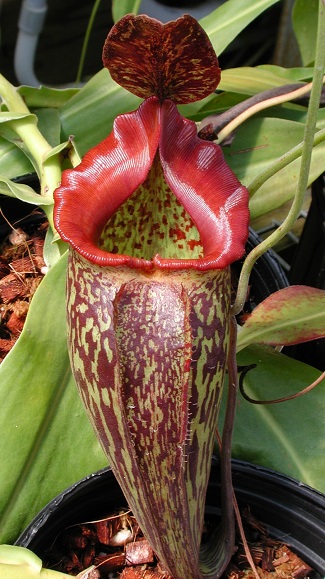Looking for something exotic to add to your plant collection? Consider tropical pitcher plants from the genus Nepenthes. Once thought to be demanding and difficult to grow, the reality is just the opposite. Selecting from the many easier to grow species and hybrids can yield excellent results and provide a unique and exotic look to your plant collection.
History

There are over 120 species of Nepenthes in the wild. They can be found in tropical Asia from sea level to alpine meadows over 9,000 feet, with the majority of the species found in Borneo and Sumatra.
Nepenthes first entered cultivation in the late 1800’s. A few hybrids made during this Victorian era survived the collapse of the great English hothouses, during the turn of the century and are still available today, handed down as rooted cuttings from one grower to another for the past 130 years. Nepenthes culture and culture in carnivorous plants (cp’s) fell out of favor until the mid 1970’s, when interest began again. Up until that time only a few species and hybrids were available among hobbyists. Availability was very limited, so plants were expensive. With the advent of tissue culture techniques for Nepenthes in the mid 1980’s more and more species have become available to hobbyists at more reasonable prices. Today nearly every species is available to the Nepenthes enthusiast. Combined with hundreds of different hybrids utilizing a wide variety of species from various climates, there are many colorful and easy to grow Nepenthes. These are not the frail and tender plants once often thought to be.
Origination
One of the keys to growing Nepenthes successfully is to select plants that fit with your own environment. The less you need to alter your growing conditions to suit the plant, the better. Nepenthes are adaptable to a point but attempting to grow a tender alpine variety that requires cold night temperatures in a hot tropical climate, without an artificially chilled grow chamber, is asking for disaster. Conversely, a plant found in hot lowland conditions and accustomed to hot humid temperatures year-round, may do okay during the warm summer months in a cold temperate environment. But will be miserable during the fall, winter, and spring when day and night temperatures are more suited to colder growing species. And likely will not survive long term without expensive heating bills during the cold months to keep the plant happy.
To grow Nepenthes successfully, one must analyze the growing environment where they would like to keep their plants. And determine the temperature range the plants will be subject to over the course of a year. This is usually broken down into three different classifications: lowland, intermediate, and highland. Lowland consists of hot days 85-95 degrees (F) with only a slight drop during the night to a low of 75-78. Intermediate consists of warm days 82-85 with a drop at night to 65. Highland has day temperatures around 78-82 with nighttime around 55. These are not exact figures, and many Nepenthes can adapt to temperatures that are close but not perfect. They may however grow slower or not perform at 100%.
The hybrids due to hybrid vigor are even more adaptable and forgiving of less-than-ideal temperatures, especially those comprised of species from both lowland and highland areas. For just starting out I recommend selecting hybrids of these types. Some Nepenthes species are also more forgiving as they occur in harsher environments and have adapted to handle wider temperature fluctuations and difficult environmental conditions. Nepenthes (N.) ventricosa, N. alata, N. maxima, N. truncata, N. khasiana, and hybrids made with these species are all excellent choices as they are among the more durable and forgiving Nepenthes species.
Cultivation
Aside from the differing temperature ranges for the various Nepenthes species and hybrids, general care and cultural conditions are remarkably similar. Nepenthes are a climbing vine and appreciate bright light. Direct morning or late afternoon sun will not harm them once they are acclimated. They have small wiry root systems and need well drained potting mix which holds a lot of moisture but yet allows the roots to breath. Too fine or heavy a mix will suffocate the roots. I recommend to most growers a mixture of fir bark, long fiber Sphagnum moss (LFS) and perlite in roughly equal quantities. Some growers are happy with pure Sphagnum moss and have excellent results. Some other possible potting mix ingredients include charcoal or coconut husk chips. Other growers use sand and Canadian peat moss as well, but I feel these are too fine and heavy in my experience.
It is important to remember that what works for one grower may not work for another. Experimentation with a variety of ingredients and combinations is important. Remember, the roots like to stay moist but should never be kept sopping wet for days on end. Likewise, they should never ever be allowed to dry out. Nepenthes originate from climates where frequent rains soak the ground, but the water drains away very quickly. They do not like water heavy with dissolved minerals and nutrients. These are carnivorous plants and have adapted to grow in environments devoid of nutrients and minerals in the soil by catching prey so high-quality water is a must for long term health. Distilled water, deionized, reverse osmosis, or collected rainwater are all excellent choices.
Nepenthes prefer moderate to high humidity levels for proper growth. The plants themselves are resilient and can grow in low humidity levels, but the pitchers are produced on tendrils from the end of the leaf blade. Insufficient humidity can cause the plant to abort pitcher growth. Although with careful plant selection and time to acclimate properly, there are choices for growers in drier climates or indoor growers with air conditioners or dehumidifiers. I have had several Nepenthes species on my West windowsill for extended periods of time and they have adapted, grown and produced pitchers without fail, even with the hot water baseboard running directly below the windowsill and a wood stove burning in the basement all winter long.
Nepenthes can also vary significantly in plant size. Some Nepenthes such as N. campanulata or N. muluensis are mature at 6” in diameter while other monsters such as N. bicalcarata can attain a diameter of 6’ from leaf tip to leaf tip. Potential plant size is a consideration when selecting Nepenthes for your collection. Nepenthes are also unique because they produce two different looking pitchers on the same plant, which are known as lower and upper pitchers. Many early botanists thought they were looking at two different species until it was revealed they were part of the same plant.
Lower pitchers are produced on young plants and basal rosettes, are larger, more colorful and tubbier shaped. Full size lower pitchers of N. merrilliana, N. truncata and N. rajah, some of the largest Nepenthes in the genus, can hold up to four quarts of fluid. Upper pitchers are produced by the climbing portion of the plant and tend to be lighter colored, smaller and more funnel shaped. The tendrils on the climbing vine can wrap around small branches to help support the vine as it climbs through surrounding vegetation.
Tony Paroubek has been growing unusual tropical plants for over 30 years and has owned and operated Par O Bek Orchids for the past 21 years. You can visit his website at ExoticPlantsPlus.com.
Photo provided by Par O Bek Orchids
Related Articles & Free Email Newsletter Sign Up
Coleus is a Versatile Plant that Comes in Over 600 Varieties




Comment here